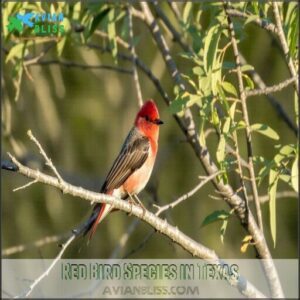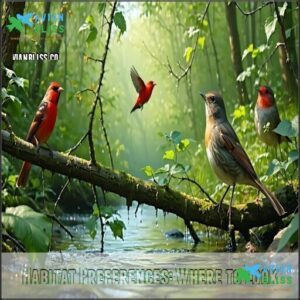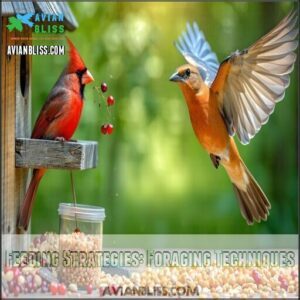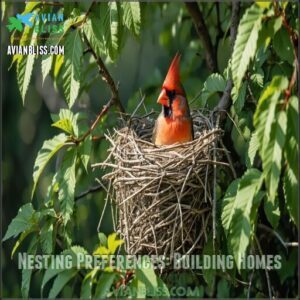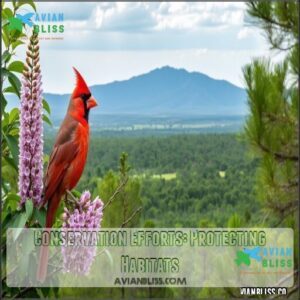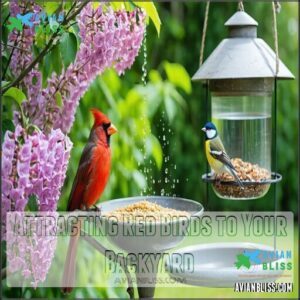This site is supported by our readers. We may earn a commission, at no cost to you, if you purchase through links.
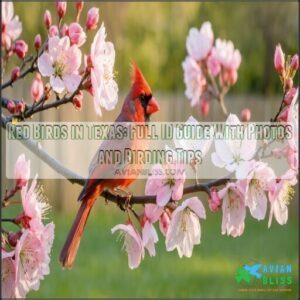 You’ll find seven key red birds in Texas: Northern Cardinals (most common), Summer Tanagers, Vermilion Flycatchers, Scarlet Tanagers, Hepatic Tanagers, House Finches, and Pyrrhuloxias.
You’ll find seven key red birds in Texas: Northern Cardinals (most common), Summer Tanagers, Vermilion Flycatchers, Scarlet Tanagers, Hepatic Tanagers, House Finches, and Pyrrhuloxias.
Each species displays unique shades of crimson, from the Cardinal’s bright scarlet to the Pyrrhuloxia’s subtle desert-rose plumage.
Males typically show more vibrant colors than females.
You can spot these feathered rubies in habitats ranging from suburban gardens to desert scrublands, depending on the species.
Listen for the Cardinal’s distinctive "cheer-cheer-cheer" or watch for the Vermilion Flycatcher’s showy aerial displays when they’re catching insects on the wing, showcasing their aerial displays.
Table Of Contents
- Key Takeaways
- Red Bird Species in Texas
- Identifying Red Birds in Texas
- Habitats and Diets of Texas Red Birds
- Attracting Red Birds to Your Backyard
- Conservation of Red Birds in Texas
- Frequently Asked Questions (FAQs)
- What is the red bird in Texas?
- What is a small red bird not a cardinal in Texas?
- What’s the difference between a cardinal and a red bird?
- How rare is it to see a cardinal in Texas?
- What is a Redbird in Texas?
- What birds are red in Texas?
- What birds live in Texas?
- Do Red Birds live in Texas?
- What bird has a red chest in Texas?
- Are red robins common in Texas?
- Conclusion
Key Takeaways
- You’ll find seven key red bird species in Texas: Northern Cardinals (most common), Summer Tanagers, Vermilion Flycatchers, Scarlet Tanagers, Hepatic Tanagers, House Finches, and Pyrrhuloxias, each displaying unique shades of crimson.
- You can attract these colorful visitors to your backyard by installing appropriate feeders (platform feeders with sunflower seeds for cardinals), providing water sources, planting native shrubs for shelter, and eliminating hazards like pesticides and window collision risks.
- Each red bird species has distinctive identification features—Northern Cardinals have black face masks and crests, Summer Tanagers are entirely red, Vermilion Flycatchers display brilliant scarlet bodies with brownish wings, and House Finches show reddish-orange plumage.
- You’ll support conservation efforts for Texas red birds by participating in citizen science initiatives like eBird and Project FeederWatch, practicing responsible birdwatching techniques, and supporting organizations dedicated to habitat preservation.
Red Bird Species in Texas
Texas hosts several distinctive red bird species including Northern Cardinals, Summer Tanagers, Vermilion Flycatchers, and House Finches that you’ll spot in various habitats across the state.
You’ll identify these crimson beauties by their unique markings, with males typically displaying more vibrant red plumage while females often show subdued coloration with reddish accents, and note the distinctive red color of these birds is a key identification feature, especially in the case of Vermilion Flycatchers.
Cardinals: Crimson Beauties of The Brush
While Northern Cardinals adorn Texas landscapes with their magnificent crimson plumage, you’ll easily spot these striking birds by their distinctive black masks and crested heads.
Northern Cardinals transform Texas landscapes with their crimson brilliance, each bird a vivid masterpiece of nature’s artistry.
These beloved backyard birds of Texas create emotional connections through:
- Their melodious whistling songs echoing at dawn
- Vibrant red males defending territories fiercely
- Subtle beauty of brownish-orange females with red accents
- Year-round presence in cardinal habitats including thickets and edges
- Charming cardinal mating rituals including seed-sharing
The combination of these characteristics makes them a joy to observe, with their distinctive black masks and crested heads being particularly notable features.
House Finches: Adaptable Red Residents
Unlike cardinals, the house finch arrived in Texas as an introduced species now thriving in urban environments.
Males display diet-derived reddish-orange plumage that females find attractive.
These adaptable red birds in Texas demonstrate remarkable urban adaptation and diet flexibility.
- Feel wonder watching males transform carotenoids from food into brilliant red feathers
- Experience surprise at their successful expansion across America
- Notice their cheerful presence at your backyard birds texas feeders
- Appreciate their social nature as they gather in noisy, friendly flocks
Tanagers: Vibrant Visitors and Residents
While house finches brighten urban settings, tanagers bring spectacular color to Texas woodlands.
Four tanager species grace the Lone Star State, with males displaying some of the most vibrant plumage in North America. These forest jewels combine beauty with fascinating behavior patterns.
| Species | Appearance | Habitat |
|---|---|---|
| Scarlet | Red body, black wings | Eastern forests |
| Summer | Entirely red (male) | Woodlands statewide |
| Hepatic | Brick-red (male) | Big Bend area |
| Flame-colored | Orange-red with gray | Rare visitor |
Look for summer tanagers eating bees and wasps in oak-pine forests, their brilliant colors flashing through the canopy.
Vermilion Flycatchers: Blazing Southwestern Gems
While tanagers bring vibrancy to Texas forests, Vermilion Flycatchers transform desert habitats into living flame displays.
These stunning red birds in texas flaunt unmistakable male plumage—brilliant scarlet bodies with brownish wings and tails.
You’ll spot them perched on low branches in southwest texas, showcasing their flycatching behavior as they dart after insects mid-air.
Their conservation status remains stable, making them reliable sightings throughout the year in open, arid landscapes.
Other Red-Hued Birds in Texas
While the vibrant vermilion flycatcher catches your eye, Texas hosts several other red-hued species worth your attention.
Beyond the familiar cardinals, you’ll encounter:
- American robins with their distinctive rusty-red breasts foraging on Texas lawns
- Red-headed woodpeckers drumming through East Texas forests
- Summer tanagers displaying their Crayola-red plumage in woodland edges
- Painted buntings flaunting spectacular multi-colored patterns with vibrant red chests
Each species occupies specific regional habitats, making Texas a paradise for redbird enthusiasts.
Many birdwatchers enjoy observing the American Robin in their backyards, and the state’s diverse range of red-hued species is a major draw.
Identifying Red Birds in Texas
You’ll discover that Texas hosts several distinctive red birds with unique features that help you tell them apart in the field.
From the crested Northern Cardinal to the vibrant Summer Tanager, each species has specific markings, behaviors, and habitats that serve as reliable identification clues.
Visual Identification: Plumage and Markings
Now that we’ve seen which red birds call Texas home, let’s examine their distinctive visual features. Identifying red birds requires attention to specific plumage details that differentiate each species.
Male vs. Female differences are particularly striking – males typically display brilliant red plumage while females often show muted tones. Seasonal changes can also affect appearance.
| Species | Male Coloration | Female Coloration | Key Markings |
|---|---|---|---|
| Northern Cardinal | Bright crimson | Buff-brown with reddish wings | Black face mask |
| House Finch | Red head and breast | Brown streaked | Notched tail |
| Summer Tanager | All-red body | Yellowish-green | Thick bill |
| Vermilion Flycatcher | Scarlet head/breast | Gray-brown with salmon belly | Dark eye line |
| Pyrrhuloxia | Gray with red highlights | Similar but duller | Curved yellow bill |
Regional variations exist throughout Texas, with some birds showing slightly different colorations depending on habitat, which can impact identification and require attention to specific plumage details and key markings to ensure accurate classification of these red birds.
Bird Songs and Calls: Auditory Clues
Listening closely to bird songs and calls can bring the vibrant world of red birds in Texas alive!
Their melodies are unique:
- Cardinal melodies: Loud, clear whistles, often “cheer-cheer-cheer.”
- Finch chirps: Sweet, chaotic warbles.
- Tanager vocals: Smooth, robin-like tunes.
Tune in to these distinctive bird sounds to sharpen your bird identification skills and enjoy nature’s concert. Sound ID apps can offer real-time species recognition for easier birding.
Habitat Preferences: Where to Look
Searching through Texas ecosystems reveals each red bird’s preferred home.
Northern Cardinals thrive in dense thickets and suburban gardens, while House Finches adapt to urban areas.
Tanager territories include forest canopies—Summer Tanagers in oak-pine woodlands and Scarlet Tanagers in deciduous forests.
Vermilion Flycatcher ranges concentrate near water in open habitats, making them visible from exposed perches.
Find Painted Buntings in central Texas and woodpeckers throughout East Texas bird habitats.
Range Maps: Tracking Distribution
Range maps unfold like treasure maps across Texas, revealing where each crimson-feathered species makes its home.
These expert-drawn tools help you pinpoint exactly when and where to spot your favorite red birds.
- Historical Distribution patterns show northern cardinal strongholds in East Texas woodlands
- Habitat Changes have pushed house finches into more urban environments
- Species Expansion tracks summer tanager populations moving northward
- Migration Patterns reveal scarlet tanagers’ brief spring appearances
- Climate Impacts show vermilion flycatchers expanding their range eastward
You’ll find these interactive maps invaluable for planning your next birding adventure.
You can also visualize changes in <strong>marine species distribution</strong> using online tools.
Habitats and Diets of Texas Red Birds
You’ll discover how Texas red birds adapt to specific environments, from the Northern Cardinal’s preference for brushy edges to the Vermilion Flycatcher’s affinity for desert waterways.
Their diets vary substantially, with cardinals cracking seeds in their powerful bills, tangers feasting on bees and wasps, and many species incorporating seasonal fruits and berries that you can use to attract these colorful visitors to your own backyard.
Preferred Food Sources: Seeds, Insects, and Fruit
Texas’s red birds have varied food preferences that attract them to different environments.
Northern Cardinals primarily eat seeds (especially sunflower seeds), fruits, and insects. House Finches favor seeds and berries, while Summer Tanagers specialize in bees and wasps.
Scarlet Tanagers seek fruits and insects high in forest canopies. Vermilion Flycatchers exclusively hunt flying insects.
To attract these crimson visitors, offer appropriate food sources matching their natural diets. These habitats are also frequented by Texas birds of prey, who hunt smaller birds, making them a key part of the ecosystem with varied food preferences and natural diets.
Feeding Strategies: Foraging Techniques
Red birds employ distinctive foraging techniques based on their species and habitat preferences.
Watch how they hunt for food:
- Cardinals and pyrrhuloxias use powerful bills for seed cracking, often ground foraging beneath feeders for dropped seeds
- Vermilion flycatchers showcase spectacular insect catching, darting from perches to snag flying bugs mid-air
- Tanagers demonstrate expert fruit consumption, carefully plucking berries while balancing on thin branches
You’ll notice these specialized feeding strategies when observing red birds at your feeders or in natural settings throughout Texas, which is a great place for bird watching.
Nesting Preferences: Building Homes
After observing birds gather food, you’ll marvel at how Texas red birds create their homes.
Northern Cardinals construct cup-shaped nests in dense shrubs using twigs, grass, and bark strips.
Tanagers prefer high oak trees for their intricate platform nests.
Vermilion Flycatchers choose exposed branches for their delicate constructions.
Each species demonstrates unique nest construction techniques, selecting specific nest locations and materials that complement their natural bird habitats in Texas.
Conservation Efforts: Protecting Habitats
While birds build homes in your backyard, large-scale habitat protection remains essential.
Conservation efforts focus on protecting critical ecosystems where Texas red birds thrive.
- Bird habitats preservation requires community engagement from everyday citizens
- Protected areas create safe havens where red species can nest undisturbed
- Habitat restoration projects rebuild damaged ecosystems one native plant at a time
- Climate resilience planning helps bird populations adapt to changing conditions
Land acquisition by conservation groups safeguards migration corridors, while citizen science initiatives help monitor population changes.
You’ll find birdwatching more rewarding knowing you’re supporting these conservation efforts.
Attracting Red Birds to Your Backyard
You’ll attract Texas red birds like cardinals, tanagers, and finches to your backyard by creating a bird-friendly habitat with appropriate feeders, water sources, shelter, and native plants.
With the right setup and by eliminating common hazards such as pesticides and window collisions, you’ll enjoy regular visits from these vibrant feathered residents, making your backyard a haven for native wildlife.
Choosing The Right Feeders: Placement and Types
Your garden’s transformation into a red bird haven starts with selecting the right feeders. Cardinals and house finches have specific preferences for successful bird watching.
| Bird Type | Feeder Recommendation | Best Seed Variety |
|---|---|---|
| Cardinals | Platform/tray feeders | Black oil sunflower, safflower |
| House Finches | Any stable feeder | Sunflower, nyjer seed |
| Both | Squirrel-proof models | Mixed seed blends |
Many options exist if you’re looking for specialized feeders.
Install feeders at 5-6 feet height near shrubs for quick escape routes. Clean feeders weekly to maintain bird health.
Providing Water Sources: Bird Baths and Drippers
Water sources create magnetic appeal for Texas birds, particularly red species like cardinals and finches.
Position bird baths in partially shaded areas with clear sightlines for bird safety. Add drippers to create gentle water movement that attracts more visitors while preventing mosquito breeding.
Maintain water quality by cleaning baths weekly with diluted vinegar. During winter, consider heated options for thawing in colder regions.
Many prefer a bird bath dripper to attract birds. Remember, consistent access to fresh water often attracts more birds than feeders alone.
Creating Shelter: Native Plants and Shrubs
After providing water, creating natural shelter completes your red birds in Texas paradise.
Native shrubs offer both protection and food for cardinals and other Texas birds. Plant dense thickets of Texas sage, yaupon holly, and American beautyberry for nesting cover and thorns protection.
Evergreen shelter like juniper provides year-round refuge, while berry-abundant plants like elderberry and sumac offer nutritious food sources.
You can find various Texas sage plant types online. Your thoughtful landscape design offers these vibrant visitors exactly what they need to thrive.
Avoiding Hazards: Pesticides and Window Collisions
Now that your bird-friendly garden is filled with native plants, it’s time to address the invisible dangers that threaten your red-feathered visitors.
Window collisions and pesticides pose serious risks to cardinals, tanagers, and other Texas birds.
To promote bird conservation in Texas:
- Install window deterrents like decals, screens, or bird-safe glass
- Eliminate chemical pesticides that cause habitat poisoning
- Place feeders either within 3 feet of windows or more than 30 feet away
- Use natural pest control methods like beneficial insects
These simple collision prevention strategies will help protect your backyard bird habitats while supporting essential bird conservation efforts.
Conservation of Red Birds in Texas
You’ll help Texas’s red birds thrive by understanding the threats they face from habitat loss and climate change.
Your participation in local conservation programs and use of bird-friendly practices in your yard directly contributes to protecting these colorful species for future generations.
Threats to Red Bird Populations: Habitat Loss and Climate Change
Nearly all Texas red birds face mounting threats from habitat fragmentation and climate impacts.
Human development has claimed over half of natural habitats, while rising temperatures alter migration patterns and food availability.
Agricultural expansion and urbanization continue to shrink critical ecosystems for species like Cardinals and Tanagers.
Pollution effects and invasive species further compound these challenges, creating unprecedented pressure on bird populations that once thrived across the Lone Star state.
Consequently, the alarming rate of building collision mortality contributes to this decline.
Citizen Science Initiatives: Monitoring and Reporting
Through citizen science initiatives, your Texas birdwatching becomes valuable data for protecting red birds.
Every observation matters in the fight against habitat loss.
Make your sightings count by joining these programs:
- Report red birds in Texas through eBird’s user-friendly platform
- Participate in the annual Christmas Bird Count with local bird watching communities
- Submit observations to Project FeederWatch during winter months
- Monitor breeding success through NestWatch’s data collection system
- Document bird collisions via D-Bird’s conservation impact reporting
By participating in these initiatives, you contribute to the protection of red birds and help ensure their populations thrive.
Supporting Conservation Organizations: Protecting Bird Habitats
Five major conservation organizations work tirelessly to protect red birds in Texas through habitat preservation efforts.
You can make a difference by supporting these groups with your time and resources.
| Organization | Focus Area | How You Can Help |
|---|---|---|
| National Audubon Society | Bird habitats | Donate/volunteer |
| Bird Conservation Alliance | Policy advocacy | Join campaigns |
| American Bird Conservancy | Extinction prevention | Fund projects |
| BirdLife International | Global partnership | Spread awareness |
| Partners in Flight | Land bird conservation | Citizen science |
The provided table outlines the key roles of each organization, including the National Audubon Society, Bird Conservation Alliance, American Bird Conservancy, BirdLife International, and Partners in Flight, allowing you to choose how to make a difference.
Responsible Birdwatching Practices: Minimizing Disturbances
While organizations work to protect habitats, individual birders play a vital role through responsible bird watching practices.
When observing Texas’s red birds, you’ll want to minimize your impact.
- Keep your distance using binoculars rather than approaching nests
- Limit flash photography that can stress birds during feeding
- Avoid playback calls that disrupt natural bird behavior
- Stay on designated trails to preserve fragile habitat
- Use ethical photography techniques that prioritize bird welfare
These simple bird watching tips guarantee our cardinal, tanager, and finch populations thrive undisturbed in their natural environments.
Frequently Asked Questions (FAQs)
What is the red bird in Texas?
Like cardinals in a cathedral, you’ll find several red birds in Texas.
The Northern Cardinal is most common, but you can also spot House Finches, Summer Tanagers, and Vermilion Flycatchers throughout the state.
What is a small red bird not a cardinal in Texas?
You’ll likely spot the House Finch in Texas, with males showing rosy red heads and upper breasts. These small birds aren’t cardinals but frequent feeders and urban areas year-round.
What’s the difference between a cardinal and a red bird?
While countless birds wear red plumage, not all are cardinals.
They are distinctive with their bright red bodies, black masks, and crests, while other red birds like tanagers and finches have different markings and no crest.
How rare is it to see a cardinal in Texas?
Northern Cardinals aren’t rare in Texas at all.
You’ll frequently spot these vibrant red birds throughout the state, especially in East and Southwest regions where they’re year-round residents.
They’re quite common visitors to backyard feeders and are a common sight.
What is a Redbird in Texas?
In Texas, a "Redbird" commonly refers to the Northern Cardinal. You’ll see these brilliant crimson males with black face masks throughout the state year-round, especially in East and Southwest regions.
What birds are red in Texas?
You’ll find several crimson beauties in the Lone Star State, including Northern Cardinals, Summer Tanagers, Vermilion Flycatchers, Scarlet Tanagers, House Finches, and Red-headed Woodpeckers.
Each sports distinctive red plumage and unique behaviors.
What birds live in Texas?
You’ll discover over 600 bird species across Texas’s diverse habitats. From eagles soaring above the Panhandle to herons wading through coastal marshes, the Lone Star State offers incredible birdwatching opportunities.
Do Red Birds live in Texas?
Yes, you’ll find several red birds in Texas including Northern Cardinals, House Finches, Summer Tanagers, Scarlet Tanagers, Vermilion Flycatchers, and the rarer Painted Buntings.
They’re widespread across different regions year-round or seasonally.
What bird has a red chest in Texas?
You’ll spot several birds with red chests in Texas, including Northern Cardinals, American Robins, House Finches, Summer Tanagers, and Vermilion Flycatchers.
The male Northern Cardinal is especially common with its vibrant red plumage, and it is one of the birds that can be spotted in Texas.
Are red robins common in Texas?
American Robins are indeed common throughout Texas.
You’ll spot them year-round, though they’re less common than Northern Cardinals.
They’re easily identified by their rusty-red breasts and dark heads with white eye markings, which makes them a notable sight.
Conclusion
Texas’s colorful feathered friends await your discovery across diverse landscapes.
With seven distinct red birds in Texas to identify, you’re equipped with knowledge about their habitats, songs, and feeding preferences.
Whether you spot a Northern Cardinal at your feeder or catch the flash of a Vermilion Flycatcher in desert scrub, each sighting brings joy.
By creating bird-friendly spaces and supporting conservation efforts, you’ll guarantee these crimson beauties continue to brighten Texas skies for generations.
- https://pmc.ncbi.nlm.nih.gov/articles/PMC9060555/
- https://www.noaa.gov/distribution-mapping-and-analysis-portal-dismap
- https://conbio.onlinelibrary.wiley.com/doi/10.1111/cobi.14221
- https://www.scienceofbirds.com/blog/top-5-global-threats-to-bird-populations
- https://datazone.birdlife.org/articles/a-range-of-threats-drives-declines-in-bird-populations

